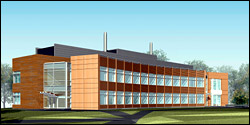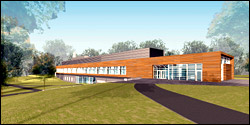
|
 |
Research > Report from the
Executive Vice President & Director of Research
Report from the Executive Vice President &
Director of Research
 |
 |
|
Jim Luyten (left) with Honorary Trustee Dick Mintz. (Photo by Elsa Ruiz) |
Despite essentially flat federal funding of ocean and earth sciences, the Institution achieved modest growth in federal support in 2003. Our investigators continued to be extremely competitive, writing more than 750 proposals to federal
agencies, foundations, and other funding sources.
While the overall picture is positive, pressure on our scientists and engineers to secure adequate support
for their work is intense. Growth in federal support
for ocean sciences has barely kept pace with inflation, let alone covered the growing cost of increasingly
sophisticated instrumentation. As a consequence,
funds allocated for the true costs of research have gradually diminished, particularly for the analysis
and publication phase of the work. Private funds have helped enormously in supporting the synthesis of diverse sets of observations and in allowing investigators
to think broadly about new areas of research. We hope federal support will not be eroded further, and are redoubling our efforts to increase private revenue
sources.
As I noted in my letter in 2002, litigation concerning
emission of sound in the ocean and its effect on marine mammals continues to have a chilling effect
on the very science that aims to understand how sound affects marine mammals. This is a concern for all oceanographic research institutions, since it has already
impacted a number of cruises for marine mammal
and geophysical studies.
On the larger issue of federal support for basic science, Congress has been outspoken in support of doubling the National Science Foundation (NSF) budget. There has been no complementary support from the Executive Branch, however, and little opportunity
to secure the necessary additional funds within the current financial constraints. We expect a small increase in the overall 2004 NSF budget, but little or no increase in 2005. What this will mean for ocean science is unknown. There are several major initiatives for the ocean sciences—the International Ocean Drilling Program, the Ocean Observatories Initiative, and the Oceanographic Fleet Renewal—but each year these get delayed another year as other programs take precedence.
We have been fortunate over the past several years to have consistent and knowledgeable leadership at NSF with Director Rita Colwell, Assistant Director for Geosciences Margaret Leinen, and Director of Ocean Sciences Jim Yoder. All three are recognized ocean scientists, and have been articulate champions for opportunities and exciting developments in the ocean sciences. Both Rita and Jim have announced their intentions to rotate out of NSF in 2004. We are hoping Margaret will stay and that whoever replaces Jim and Rita will share their passion for American leadership in oceanography.
Tools for Seagoing Science
Two major reports were completed in 2003 by the Ocean Studies
Board (OSB) of the National Research Council, part of the National
Academy of Sciences. Bob Detrick, chair of the Geology and Geophysics
Department, chaired the OSB planning study for ocean observatories,
a major NSF initiative. Observatories comprise a diverse suite
of fixed and floating instruments placed in the oceans to enable
nearly continuous measurement of ocean conditions. (Our Martha’s
Vineyard Coastal Observatory is a prototype coastal ocean observatory.
See Physical Oceanography
Department photos). The report strongly affirmed the importance
of ocean observatories to the future of scientific objectives
and opportunities in ocean sciences, and gave strong scientific
and technical support to the NSF Ocean Observatories Initiative.
The OSB also reported on future needs for the nation’s deep
submergence vehicles and technology. This report acknowledged
WHOI’s leadership in deep submergence technology and urged the
NSF to support replacement of the deep submergence research
vehicle Alvin.
Launched in 1964, Alvin has been the preeminent human-occupied
submersible for 40 years. Despite continual upgrades, Alvin
has reached the end of its useful life and a new submersible
will enhance our nation’s ability to dive deeper and faster,
carry greater payloads, and accommodate more modern research
techniques and technologies. This is good news and we are pursuing
next steps with the NSF. In addition, the Institution won federal
support to design and build the next-generation robotic vehicle
capable of going to the deepest depths of the ocean, the Mariana
Trench, which, at just under 37,000 feet (11,000 meters), is
deeper than Mt. Everest is high. This new vehicle, scheduled
for prototype testing in 2005, will be a hybrid of a fully autonomous
vehicle, like our Autonomous Benthic Explorer and our tethered,
remotely controlled vehicle Jason II.

|

|
| Architect’s rendering of the Biogeochemistry Laboratory (left) and the Marine Research Facility on the Quissett Campus, which will increase space for science by 30 percent. (Courtesy of Ellenzweig Associates) |
Improvements Ashore
We also made progress this year in improving our shore facilities. Recovery from a fire in a laboratory on the first floor of the Clark Laboratory continues. Most of the laboratories are back in use and replacements
for damaged equipment have been installed and are operating. Repair and refurbishment of the instrument most affected by the fire, the ion microprobe,
are underway. We expect the equipment to be fully operational in 18 to 24 months.
Plans for a major upgrade in our science facilities on the Quissett
Campus are in the final stages, and we expect construction of
new facilities (above) to be well underway by the second quarter
of 2004. We will build two new laboratory buildings, two additions
to the McLean Laboratory, and make associated infrastructure
improvements. This 30 percent increase in research laboratory
space will provide much-needed relief from overcrowding in the
Fye and Redfield laboratories and will represent a significant
step in providing state-of-the-art facilities for research in
biogeochemistry. New construction will also provide the space
to bring together a large and diverse group of investigators
interested in marine mammals. We anticipate that the buildings
will be completed in late 2005.
We ended 2003 poised to begin ambitious and timely campus improvements and with exciting prospects
for renewal of ocean-based facilities. I am cautiously
optimistic about the future of our federal support. While we will be diligent in rallying federal support for our work, we will intensify our pursuit of alternative support for exploration and discovery.
—James Luyten (jluyten@whoi.edu)
Executive Vice President & Director of Research
|
|
